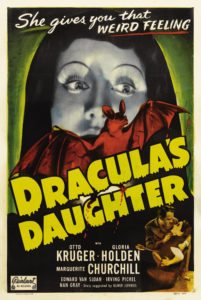 The classic horror films made by Universal had no shortage of monstrous men, such as Bela Lugosi’s Dracula and Boris Karloff’s Frankenstein’s monster. Monstrous women, on the other hand, were few and far between.
The classic horror films made by Universal had no shortage of monstrous men, such as Bela Lugosi’s Dracula and Boris Karloff’s Frankenstein’s monster. Monstrous women, on the other hand, were few and far between.
The Bride of Frankenstein, iconic as she is, appears so briefly in her self-titled 1935 film that she can scarcely be described as a character. The Invisible Woman (1940) rejected horror in favour of broad comedy. Captive Wild Woman (1943) was commercially successful enough in its day to spawn two sequels, but its lasting impact on popular culture is negligible. She-Wolf of London (1946) had the misfortune to be produced at a time in which supernatural horror was somewhat passé, and featured an anti-heroine who merely thought that she was a werewolf. Hammer Film Productions, which took the horror baton from Universal in the late 1950s, showed a fondness for vampish femmes fatales, but the horror films of Universal’s classic period had little time for female monsters.
The one significant exception to this is the 1936 film Dracula’s Daughter, directed by Lambert Hillyer.
Released a year after Bride of Frankenstein, Dracula’s Daughter was the second of Universal’s horror sequels. The film marked the end of an era: the studio moved away from horror films shortly afterwards, possibly due to the lucrative British market being curtailed by censorship. Universal did not return to the genre until 1939, and its second cycle of horror films – beginning with Son of Frankenstein – was markedly tamer and more derivative than the initial wave. The daughter of Dracula, then, was the final creation from the golden years of Universal horror.
The Story
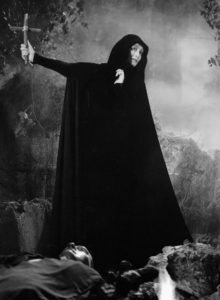
Dracula’s Daughter begins with Professor Van Helsing – whose name has inexplicably changed to Von Helsing since the previous film in the series – being apprehended for the murder of Count Dracula. The Professor protests that Dracula was a vampire, and that his death had actually occurred four hundred years ago.
Von Helsing is taken before the local police commissioner, Sir Basil Humphrey. The professor takes the opportunity to paraphrase one of the most memorable lines from the previous film: “The strength of the vampire, Sir Basil, lies in the fact that he is unbelievable.” In 1936 the vampire was not quite as widely-recognised a fictional subject as it is now, and so Von Helsing offers a description of exactly what a vampire is:
The undead…creatures who have never died, who prolong their unnatural lives by draining the blood of the living. At night they leave their graves and roam abroad like wolves, seeking their prey. When daylight comes they must return to their graves or die.
While the Count’s body is being held by the authorities, a mysterious woman arrives and requests to see it. The bumbling police officer in charge of the cadaver tries to turn her away; but holding her ring before his face, she places him into a trance and steals Dracula’s body.
Outside, the woman burns the corpse in an impromptu funeral pyre. She holds up a cross, at which she cannot bring herself to look, and recites a prayer:
Unto Adonai and Azrael, unto the keeping of the lords of the flame and lower pits I consign this body to be forevermore consumed in this purging fire. Let all baleful spirits that threaten the souls of men be banished by the sprinkling of this salt. Be thou exorcised, o Dracula, and thy body long undead find destruction through eternity in the name of thy dark and unholy master. In the name of the all holiest, and through this cross, be the evil spirit cast out until the end of time.
The woman is Countess Marya Zaleska, a vampire – albeit a reluctant one. Her prayer reflects a curiously unspecific form of Abrahamic religion, combining a Hebrew name of God (Adonai) and the image of the cross alongside an invocation of the angel Azrael. While regarded as a benevolent figure in Judaism, Azrael or Azriel is viewed as the angel of death in Islamic tradition; it is this latter interpretation that was lifted by Western writers such as Bramwell Brontë, Rudyard Kipling, and Jean Cocteau, and appears to have inspired his brief mention in Dracula’s Daughter.
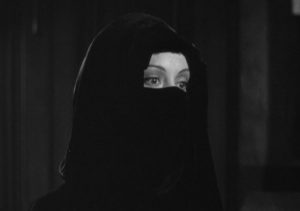
During this scene Zaleska reveals her face for the first time, having been previously wrapped almost head to toe in black with only her eyes visible. This was presumably intended as a disguise while she stole Dracula’s body, but the unmistakable result is that she resembles a woman wearing an Islamic burqa and veil. In contrast to the negative connotations of today, this attire was once seen in the West as exotic and mysterious: turn-of-the-century “harem” imagery, such as the work of Swiss photographer Jean Geiser, showed a fondness for Muslim women with veiled faces and bared breasts. Bram Stoker located Dracula within an exotic Eastern Europe (“every known superstition in the world is gathered into the horseshoe of the Carpathians, as if it were the centre of some sort of imaginative whirlpool”) and Zaleska’s initial portrayal appears to mix this imagined region with a similarly exotic and mysterious vision of the Middle East.
Having performed her ritual, Zaleska announces to her servant Sandor that she is “free to live as a woman, free to take my place in the bright world of the living instead of among the shadows of the dead.” She clearly has lingering doubts about the effectiveness of her cure, however, and heads back to her flat before dawn arrives.
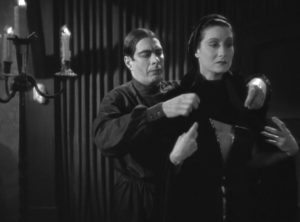
The next night she expresses a desire to “think normal things, even play normal music again” and sits down at a piano to play “the cradle song, the song my mother once sang to me long, long ago, rocking me as she sang in the twilight.” She then asks Sandor what he sees in her eyes. “Death,” comes his simple reply.
The scene ends with Zaleska finally giving in to her vampiric compulsions. She heads outside and, finding a young man, places him into a trance. The film then cuts to the man’s autopsy, with surgeons commenting on the loss of his blood and the mysterious marks on his neck…
Meanwhile, the disappearance of Dracula’s body has led to the murder charge against Von Helsing being dropped. But the professor persists in his claims that the departed Count was a vampire; a former student of his, the psychiatrist Jeffrey Garth, arrives in London to defend his case.
Attending a party, Jeffrey notices a gloomy painting on the wall. One of the guests introduces him to the artist: Countess Marya Zaleska. As Jeffrey chats with the other partygoers, he states his belief that Von Helsing’s notions about vampires are the result of a mental illness that can be cured. Upon hearing this, Zaleska hits upon a new possibility: can this psychiatrist cure her, as well?
Tension between the supernatural and the scientific is a recurring theme in the Universal horror films. It can be found in the Frankenstein series; most obviously in Bride of Frankenstein (1935), when the monster’s creator proclaims “this isn’t science, it’s more like black magic” upon seeing the work of the alchemist-like Dr. Pretorius. It can be found in The Wolf Man (1941), characters in which articulate the possibly psychological origin of lycanthropy even as we see the main character transform into a lupine fiend. It can be found, in admittedly cruder form, in House of Dracula (1945), which posits unconvincing pseudo-scientific explanations for vampires and werewolves.
In Dracula’s Daughter, the theme comes to the fore when Jeffrey is first reunited with Von Helsing prior to meeting Zaleska. The vampire-slaying professor asks Jeffery “who can define the boundary line between the superstition of today and the scientific fact of tomorrow?” and cites hypnosis as a phenomenon that gained acceptance despite being once dismissed. Both before and after this line is delivered, the film shows Zaleska placing her victims into trances. However, we eventually learn that the process is not hypnosis as science would understand it, but “something far older.” In other words, it is not science – it is more like black magic.
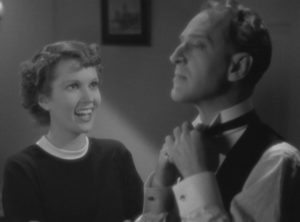
Jeffrey heads to Zaleska’s flat so that he can give her a private therapy session. Once there, he remarks that her home is the “first woman’s flat I‘ve ever been in that did not have twenty mirrors in it.” Modern audiences would grasp the significance of this right away, of course, but in 1936 it was necessary for the dialogue to establish the “old Hungarian legend” (actually invented by Bram Stoker) that vampires do not cast reflections.
Zaleska refuses to reveal her exact problem, stating that it exists outside of scientific knowledge: “There are more things in heaven and earth than are dreamed of in your psychiatry.” She does, however, make an effort to outline her condition in vague terms.
“Do you believe that the dead could influence the living? Could you conceive of a superhuman mentality, influencing someone from the other side of death?” she asks. “There is such a one. Someone, something that reaches out from beyond the grave and fills me with horrible impulses.”
Jeffrey concludes that the solution to her problem is mental willpower, telling her that one treatment for alcoholics involves being left in a room with drink and encouraged to fight their urges to consume it. Zaleska decides to put this idea to the test: at night, she sends Sandor to procure a young woman who will act as a model for her latest painting.
The resulting scene is perhaps the most famous in the film. At her studio, Zaleska asks the young woman – Lili – to partially undress: “I’m doing a study of a young girl’s head and shoulders; you won’t object to removing your blouse, will you?”
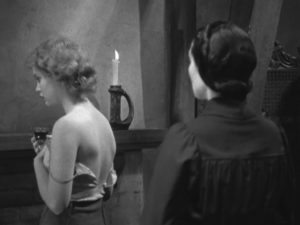
Lili does so, and then pointedly lowers the straps on her bra (“I suppose you’ll want these pulled down, won’t you?”). Zaleska stares at her intently; Lili, growing uncomfortable, asks to leave (“Why are you looking at me that way…? I think I’ll go, if you don’t mind.”). Zaleska continues towards her, still staring. As Lili screams, the camera pans up to a grinning mask that hangs on the wall. The next shot is Lili’s motionless body being unloaded from an ambulance.
Lili is not dead, but merely in a trance. Jeffrey examines her and, noticing bite marks on her neck, realises that there may be truth in Von Helsing’s bizarre claims after all. Using hypnosis, Jeffrey retrieves Lili’s memory of being attacked in Zaleska’s studio – just as, in Stoker’s novel, Van Helsing deduces Dracula’s whereabouts by hypnotising Mina Harker.
Jeffrey confronts Zaleska, at which point the countess reveals her secret. “There isn’t anything I won’t do now to enlist your aid in freeing me of the curse of the Draculas… I am Dracula’s daughter.”
It is not entirely clear whether Zaleska’s status as the daughter of Dracula is meant to be taken literally or figuratively. After all, Von Helsing remarks in an earlier scene that “Dracula had many victims… into whose veins he infused his own tainted blood, making them creatures like himself,” hinting at Zaleska being a victim of Dracula. Perhaps the ambiguity is deliberate, so as to prevent the audience from getting hung up on the paradoxical notion of the undead giving birth.
Next, Zaleska makes a second revelation: she has kidnapped Jeffrey’s secretary, Janet. She then flees, resulting in a chase that leads Jeffrey, Von Helsing, and the police commissioner Sir Basil back to Zaleska’s family home in Transylvania.
As she awaits Jeffrey Garth, Zaleska tells Sandor that she no longer hopes to be cured; her new plan is to turn Jeffrey into a vampire and live with him forever. “Have you forgotten your promise, that I was to have eternal life?” asks Sandor. He goes on to make a threat: “there is death for Garth if he comes here… and destruction for you.”
When Jeffrey arrives, Zaleska makes her offer. He accepts it, being desperate to save Janet. Sandor then intervenes by killing Zaleska, substituting an arrow for the traditional stake. Finally, Sandor is gunned down in turn by a policeman accompanying Sir Basil.
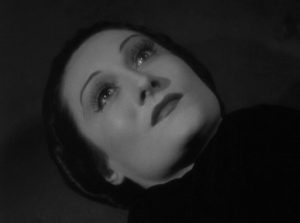
As Jeffrey tends to Janet, Von Helsing and Sir Basil examine Zaleska’s corpse.
“The woman is beautiful,” remarks the police commissioner.
“She was beautiful when she died, a hundred years ago,” replies Von Helsing, in a line that recalls the famous final exchange from King Kong. According to Ramsey Campbell’s introduction to his 1977 novelisation, Von Helsing’s line as previously scripted was to have been rather more pious: “All souls are beautiful in the eyes of God.” The implication, here, is that Zaleska’s soul may have finally found salvation.
To be Continued
So goes the story of Dracula’s Daughter. But what was the creative process behind the film? What kind of literary antecedents does Countess Zaleska have? And what are we to make of the film’s homosexual undertones? These are questions that I shall try to answer in the second article of this series.

